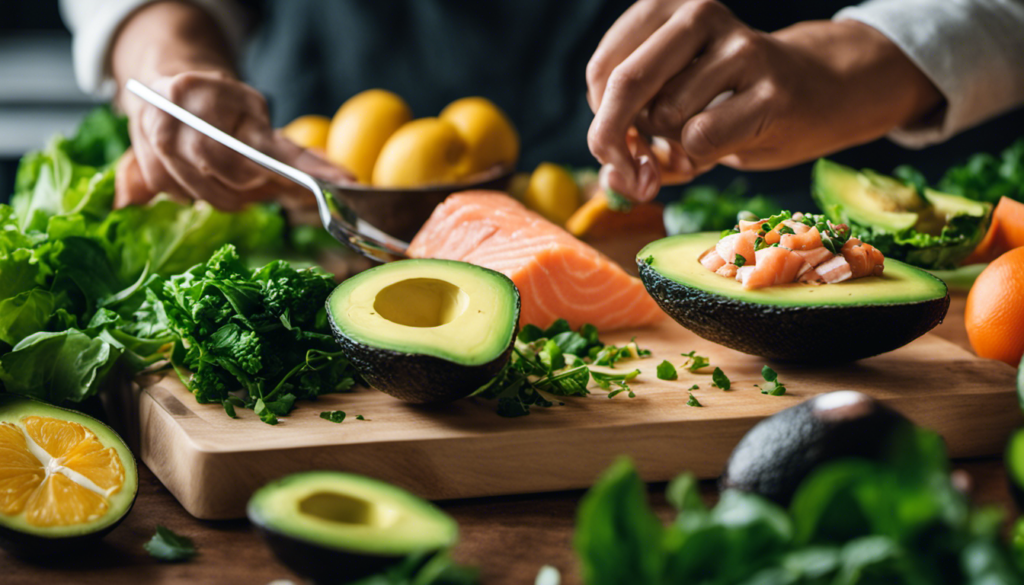Are you ready to embark on a keto diet journey? Brace yourself, because just like any new adventure, there may be some bumps along the way. One particularly common hurdle that many people face during the first weeks of a keto diet is what’s known as the ‘keto flu.’
But fear not, because in this article, we’ve got your back. We’ll show you how to overcome the keto flu and make your transition into ketosis as smooth as possible. By understanding the symptoms and causes of the keto flu, staying hydrated, gradually transitioning into ketosis, and incorporating nutrient-rich foods, you’ll be well on your way to feeling your best self on this new diet.
And remember, seeking professional guidance and support is always a great idea to ensure your safety and success. So, let’s dive in and conquer the keto flu together!
Key Takeaways
- Staying hydrated and maintaining electrolyte balance helps alleviate symptoms of the keto flu.
- Gradually transitioning into ketosis by reducing carbohydrate intake over a few weeks can reduce the chances of experiencing the keto flu and carb cravings.
- Incorporating healthy fats and nutrient-rich foods like avocados, nuts, and leafy greens is important for a successful keto diet.
- Seeking professional guidance and support can provide personalized meal plans, expert advice on portion sizes and food choices, and access to a supportive network in online communities.
Understanding the Keto Flu
Don’t let the keto flu put a damper on your excitement for starting a keto diet! It’s important to understand the causes and symptoms of the keto flu so you can take steps to overcome it.
The keto flu is a collection of symptoms that occur during the first few weeks of a keto diet as your body adjusts to burning fat for fuel instead of carbohydrates. The main cause of the keto flu is the transition from a high-carb to a low-carb diet, which can cause your body to experience withdrawal-like symptoms.
Common symptoms include fatigue, headache, irritability, dizziness, and nausea. To overcome the keto flu, it’s important to stay hydrated and maintain electrolyte balance. This will help alleviate symptoms and support your body’s adjustment to the new diet.
Staying Hydrated and Electrolyte Balance
Stay on top of your hydration game and make sure your electrolytes are in balance, like a tightrope walker gracefully maintaining equilibrium. When starting a keto diet, it’s important to stay well-hydrated and maintain proper electrolyte levels. Here are a few key ways to achieve this:
Increase your water intake: Aim for at least 8 glasses of water per day to prevent dehydration, which can worsen keto flu symptoms.
Consume electrolyte-rich foods: Include foods like avocados, spinach, and nuts in your diet to naturally boost your electrolyte levels.
Consider electrolyte supplements: If you’re struggling to meet your electrolyte needs through food alone, talk to your healthcare provider about adding electrolyte supplements to your routine.
Be mindful of potassium and magnesium: These electrolytes are especially important on a keto diet. Include potassium-rich foods like salmon and spinach, and consider taking a magnesium supplement if needed.
By taking these steps, you’ll set yourself up for success in managing the keto flu symptoms. As you gradually transition into ketosis, it’s important to continue prioritizing your hydration and electrolyte balance.
Gradually Transitioning into Ketosis
As you ease into the world of ketosis, it’s important to gradually adjust your body to this new metabolic state. Transitioning smoothly into ketosis can help you avoid the dreaded keto flu and minimize carb cravings. Gradually reducing your carbohydrate intake over a period of a few weeks can give your body time to adapt and make the transition more manageable. Start by cutting back on high-carb foods and replacing them with low-carb alternatives. This will help your body gradually shift from relying on carbohydrates for energy to using stored fat instead. To help you stay on track, here’s a table outlining some high-carb foods and their low-carb alternatives:
| High-Carb Foods | Low-Carb Alternatives |
|---|---|
| Bread | Lettuce wraps |
| Pasta | Zucchini noodles |
| Rice | Cauliflower rice |
| Potatoes | Cauliflower mash |
| Sugar | Stevia or erythritol |
By gradually transitioning into ketosis and making smart food swaps, you can reduce the chances of experiencing the keto flu and carb cravings. Now let’s move on to incorporating healthy fats and nutrient-rich foods to support your keto journey.
Incorporating Healthy Fats and Nutrient-Rich Foods
Embrace the richness of healthy fats and nutrient-dense foods as they become your keto journey’s nourishing companions. Incorporate vegetarian options into your keto diet to provide a wide array of essential nutrients.
Include foods like avocados, nuts, seeds, olive oil, and coconut oil to ensure you are getting enough healthy fats. These options are not only delicious but also provide important vitamins and minerals.
Explore keto-friendly recipes that incorporate these ingredients to keep your meals exciting and satisfying. Experiment with cauliflower rice, zucchini noodles, and tofu to add variety to your plate.
Remember to prioritize nutrient-rich foods such as leafy greens, broccoli, and berries to ensure you are meeting your micronutrient needs.
As you continue your keto journey, seeking professional guidance and support will further enhance your success in overcoming the keto flu and maintaining a healthy lifestyle.
Seeking Professional Guidance and Support
If you’re looking to optimize your keto journey and ensure long-term success, it’s worth considering the benefits of seeking professional guidance and support. Professional advice can provide you with the knowledge and expertise needed to navigate the challenges of the keto diet and overcome the keto flu. A qualified nutritionist or dietitian can help create a personalized meal plan that meets your nutritional needs and minimizes the risk of nutrient deficiencies. They can also offer guidance on portion sizes, food choices, and supplementation if necessary. Additionally, joining online communities dedicated to the keto diet can provide you with a supportive network of individuals who are going through similar experiences. These communities offer a platform for sharing tips, recipes, and success stories, as well as offering a space to ask questions and seek advice. Seeking professional guidance and being part of an online community can enhance your keto experience and increase your chances of long-term success.
| Pros of seeking professional guidance and support | Cons of seeking professional guidance and support |
|---|---|
| Personalized meal plans tailored to your needs | Costly consultations |
| Expert advice on portion sizes and food choices | Limited availability in certain areas |
| Guidance on supplementation if necessary | Potential differences in opinions and approaches |
| Access to a supportive network in online communities |
Frequently Asked Questions
Can I still exercise while experiencing the keto flu?
While experiencing the keto flu, it’s like trudging through a muddy obstacle course. But fear not, dear warrior, for you can still exercise during this challenging time. Just listen to your body and adjust your intensity accordingly.
Keep in mind that your energy levels might be lower, so choose activities that don’t drain you completely. Remember to stay hydrated, replenish electrolytes, and give yourself enough rest.
Your body will adapt, and soon you’ll conquer the keto flu like a true champion.
Is it normal to experience cravings while transitioning into ketosis?
It is normal to experience cravings while transitioning into ketosis. These cravings are often a result of sugar withdrawal, as your body adjusts to a lower carbohydrate intake.
To help manage these cravings, it is important to focus on consuming a variety of nutrient-dense foods that are allowed on the keto diet. This includes healthy fats, protein, and low-carb vegetables.
Staying hydrated and getting enough sleep can also help reduce cravings.
How long does the keto flu typically last?
The duration of the keto flu can vary from person to person, but it typically lasts for about a week or two.
During this time, you may experience symptoms such as fatigue, headaches, and irritability.
However, there are coping strategies that can help alleviate these symptoms.
Staying hydrated, replenishing electrolytes, and gradually reducing carbohydrate intake can all help ease the transition into ketosis.
Remember, ‘patience is a virtue’ – give your body time to adjust and the keto flu will pass.
Can I take over-the-counter medications to alleviate the symptoms of the keto flu?
Yes, you can take over-the-counter medications to alleviate the symptoms of the keto flu. Natural remedies, such as electrolyte supplements or BHB salts, can help replenish electrolytes and reduce fatigue and muscle cramps. Herbal teas or essential oils may also provide relief. It’s important to make lifestyle changes, such as managing stress, getting enough sleep, and staying hydrated, as these can contribute to symptom management. Modifying your diet to include more nutrient-dense foods can also support your body during this transition.
Are there any specific foods or supplements that can help alleviate the symptoms of the keto flu?
To alleviate the symptoms of the keto flu, there are specific foods and supplements that can help. Incorporating foods high in electrolytes like sodium, potassium, and magnesium, such as avocados, spinach, and nuts, can replenish your body.
Additionally, taking supplements like electrolyte powders or magnesium supplements can provide relief.
Natural remedies like drinking bone broth or increasing water intake can also help.
These alternative treatments can support your body during the adjustment period of the keto diet.
Conclusion
Congratulations on taking the first step towards a healthier lifestyle by starting a keto diet!
While the initial weeks may be challenging due to the keto flu, there are ways to overcome it.
Remember to stay hydrated and maintain electrolyte balance to alleviate symptoms.
Gradually transitioning into ketosis and incorporating nutrient-rich foods and healthy fats will also help.
Don’t hesitate to seek professional guidance and support.
With these strategies, you’ll be on your way to a successful keto journey, embracing the euphoria of a revitalized you.








